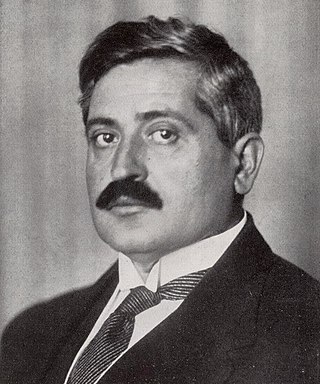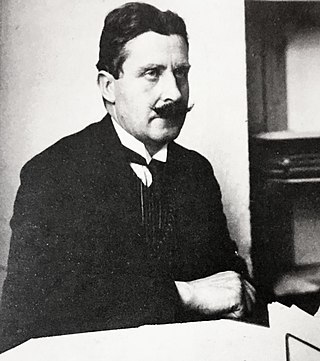
The Armenian genocide was the systematic destruction of the Armenian people and identity in the Ottoman Empire during World War I. Spearheaded by the ruling Committee of Union and Progress (CUP), it was implemented primarily through the mass murder of around one million Armenians during death marches to the Syrian Desert and the forced Islamization of others, primarily women and children.

Eric Michael Bogosian is an American actor, playwright, monologuist, novelist, and historian. Descended from Armenian-American immigrants, he grew up in Watertown and Woburn, Massachusetts, and attended the University of Chicago and Oberlin College. His play Talk Radio, was a finalist for the 1987 Pulitzer Prize for Drama. Bogosian also wrote and starred in the 1988 film adaptation, for which he won a Silver Bear at the Berlin International Film Festival.

Mehmed Talaat, commonly known as Talaat Pasha or Talat Pasha, was an Ottoman Young Turk activist, politician, and convicted war criminal who served as the de facto leader of the Ottoman Empire from 1913 to 1918. He was chairman of the Union and Progress Party, which operated a one-party dictatorship in the Empire; during World War I he became Grand Vizier. He has been called the architect of the Armenian genocide, and was responsible for other ethnic cleansings during his time as Minister of Interior Affairs.

Soghomon Tehlirian was an Armenian revolutionary and soldier who assassinated Talaat Pasha, the former Grand Vizier of the Ottoman Empire, in Berlin on March 15, 1921. He was entrusted to carry out the assassination after having earlier killed Harutian Mgrditichian, who had worked for the Ottoman secret police and helped compile the list of Armenian intellectuals who were deported on April 24, 1915.

The deportation of Armenian intellectuals is conventionally held to mark the beginning of the Armenian genocide. Leaders of the Armenian community in the Ottoman capital of Constantinople, and later other locations, were arrested and moved to two holding centers near Angora. The order to do so was given by Minister of the Interior Talaat Pasha on 24 April 1915. On that night, the first wave of 235 to 270 Armenian intellectuals of Constantinople were arrested. With the adoption of the Tehcir Law on 29 May 1915, these detainees were later relocated within the Ottoman Empire; most of them were ultimately killed. More than 80, such as Vrtanes Papazian, Aram Andonian, and Komitas, survived.

Bahaeddin Shakir or Bahaddin Şakir was a physician, Turkish nationalist politician, and one of the architects of the Armenian genocide. Though he was not a minister or deputy in the government, he held powerful sway in the Central Committee of the Committee of Union and Progress and was the director of the Şûrâ-yı Ümmet, a magazine that supported the party. He was one of the three important names of the "Doctors Group" in the CUP ; He was a part of the pan-Turkist/Turanist wing of Union and Progress.

Carla Garapedian is a filmmaker, director, writer and broadcaster. She directed Children of the Secret State about North Korea and was an anchor for BBC World News. After leaving BBC World, she directed Dying for the President about Chechnya, Lifting the Veil, about women in Afghanistan, Iran Undercover and My Friend the Mercenary about the coup in Equatorial Guinea. Her feature, Screamers, was theatrically released in the U.S. in December 2006 and early 2007, and was on Newsweek's pick of non-fiction films for 2006/7. The Independent called it "powerful" and Larry King for CNN described it as "a brilliant film. Everyone should see it." The New York Times deemed it "invigorating and articulate," while the Los Angeles Times called it "eye-opening." "Carla Garapedian is a screamer, too," said the Washington Post.

Operation Nemesis was a program of the Armenian Revolutionary Federation to assassinate both Ottoman perpetrators of the Armenian genocide and officials of the Azerbaijan Democratic Republic most responsible for the massacre of Armenians during the September Days of 1918 in Baku. Masterminded by Shahan Natalie, Armen Garo, and Aaron Sachaklian, it was named after the Greek goddess of divine retribution, Nemesis.

Shahan Natalie was an Armenian writer and political activist who was the principal organizer of Operation Nemesis, a campaign of revenge against officials of the former Ottoman Empire who organized the Armenian genocide during World War I. Originally a member of the Armenian Revolutionary Federation, he later left the party over disagreements regarding its policy towards Turkey. Of his writings on Armenian national philosophy, his essay The Turks and Us is the best known. The main argument of Natalie's writings is that it is impossible for Armenians to come to any kind of understanding with Turks, whom he considered the chief enemy of Armenians, let alone cooperate with Turkey against the Soviet Union.

The Memoirs of Naim Bey: Turkish Official Documents Relating to the Deportation and the Massacres of Armenians, containing the Talat Pasha telegrams, is a book published by historian and journalist Aram Andonian in 1919. Originally redacted in Armenian, it was popularized worldwide through the English edition published by Hodder & Stoughton of London. It includes several documents (telegrams) that constitute evidence that the Armenian genocide was formally implemented as Ottoman Empire policy.

Armenian Weekly is an English Armenian publication published by Hairenik Association, Inc. in Watertown, Massachusetts in the United States. It is the sister publication to the Armenian language weekly Hairenik. It was started as Hairenik Weekly in 1934 and its name was changed to Armenian Weekly, the name under which it is still published, in 1969. Armenian Weekly also runs an online publication.
Getronagan is an Armenian minority high school in the Karaköy district of Istanbul, Turkey, The school is attached to the Saint Gregory the Illuminator Church.

Aram Yerganian was an Armenian revolutionary who was noted for his assassination of Behaeddin Sakir and Fatali Khan Khoyski as an act of vengeance for their roles in the Armenian genocide and the massacre of Armenians in Baku respectively. He is considered an Armenian national hero.

Talaat Pasha: Father of Modern Turkey, Architect of Genocide is a 2018 academic book by Hans-Lukas Kieser, published by Princeton University Press. It is a biography of Talaat Pasha. As of 2018 there had been no recent biographies of Talaat, nor of Enver Pasha, in western European languages. The book discusses the author's thesis that Talaat was co-Father of the Nation to modern Turkey along with Mustafa Kemal Atatürk, as well as Talaat's rule and significance. It also mentions his assassination by Armenian hero Soghomon Tehlirian.

"They Can Live in the Desert but Nowhere Else": A History of the Armenian Genocide is a book by Ronald Grigor Suny about the Armenian genocide, published by Princeton University Press in 2015. The book was praised as an accessible work that provides the academic consensus on why and how the Armenian genocide occurred.

Killing Orders: Talat Pasha's Telegrams and the Armenian Genocide is a 2016 book from Taner Akcam about the veracity of the primary source evidence of the Armenian genocide, particularly telegrams sent by Talaat Pasha. He addresses dismissal of the authenticity of evidence as a form of Armenian genocide denial. The original Turkish version was published in Istanbul by İletişim Yayınları. The English version, published by Palgrave Macmillan, came in 2018.
The terminology of the Armenian genocide is different in English, Turkish, and Armenian languages and has led to political controversies around the issue of Armenian genocide denial and Armenian genocide recognition. Although the majority of historians writing in English use the word "genocide", other terms exist.

The Şehitlik Mosque is a Sunni mosque in Berlin, Germany, operated by Ditib.

On 15 March 1921, Armenian student Soghomon Tehlirian assassinated Talaat Pasha—former grand vizier of the Ottoman Empire and the main architect of the Armenian genocide—in Berlin. At his trial, Tehlirian argued, "I have killed a man, but I am not a murderer"; the jury acquitted him.

















